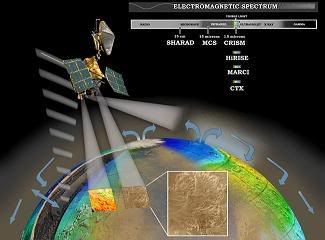Post by glactus on Feb 23, 2008 1:33:33 GMT

The reconnaisance orbiter over Mars
After decades of studying the climate conditions of Mars, scientists have recently made a breakthrough observation.
At the last conference of the American Geophysical Union (AGU) in San Francisco, Dr. Adrian Brown reported on the latest results of the instrument that led his team to find water on Mars. Brown, a research scientist at the SETI Institute who studies climate similarities between Mars and Earth, says that finding water on Mars makes the potential for past or even future life on Mars much better.
The Compact Reconnaissance Imaging Spectrometer for Mars, or CRISM, is the instrument that made possible the recent discovery of Brown's team. Johns Hopkins University in Maryland operates CRISM, which is carried onboard NASA's Mars Reconnaissance Orbiter. CRISM has twenty times the resolution of past Mars mineral mappers, allowing an unprecedented analysis of surface content, as well as the first compositional mineral maps of Mars
The south polar cap of Mars grows and retracts seasonally, similar to the polar caps on Earth. As Brown said, "Understanding that whole system as a function of time is really important and what CRISM allows us the opportunity to do. And that is the work that we were reporting on at the recent AGU conference, looking at the spring recession of CO2 ice."
"We found some pretty interesting, unexpected effects that we haven't been able to find before with this CO2 ice and water ice interaction."

Mars scientist
credits:
Original source: The SETI institute:
Article presentation By Emily Wanderer of the University of Oregon.
This is part text only. See image, full text and all scientists involved at space.com
www.space.com/searchforlife/080221-seti-crism-water.html


